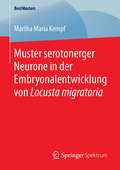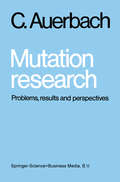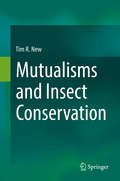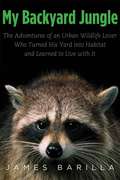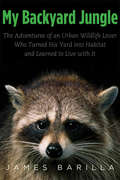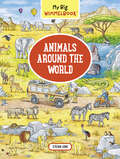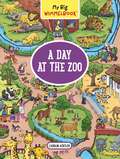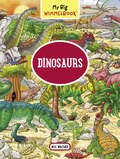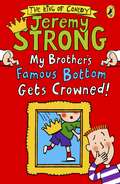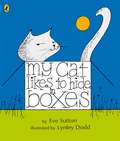- Table View
- List View
Muslimische Patienten pflegen: Praxisbuch für Betreuung und Kommunikation
by Alexandra Bose Jeanette TerpstraIn Deutschland leben ca. 4 Millionen Muslime und die Zahl der älteren Migranten steigt. So versorgen beruflich Pflegende immer häufiger kranke und pflegebedürftige Menschen, die einen anderen kulturellen Hintergrund haben. In der medizinischen und pflegerischen Betreuung kommt es zwischen Migranten und Pflegepersonal durch die kulturellen Unterschiede oft zu Konfliktsituationen und Störungen im Behandlungs- und Stationsablauf. Auslöser sind Stereotype, Unwissenheit und Verständigungsschwierigkeiten.Die Autorinnen unterstützen mit dieser Praxisfibel einen konfliktfreien Umgang mit muslimischen Migranten. An einzelnen Fallsituationen aus dem Klinik- und Pflegealltag werden Probleme dargestellt, kulturelle Hintergründe erläutert und Handlungsanregungen vorgeschlagen. Pflegende erhalten konkrete Tipps wie sie häufig auftretende Stress- und Konfliktsituationen mit muslimischen Patienten meistern. Das Kapitel über die Grundlagen der islamischen Kultur, z.B. zum Wertesystem, Rituale, Rollenverhalten, Krankheitsverständnis, fördert das Verständnis für die andere Kultur und hilft Konflikten vorzubeugen. Einfach und praktisch: Ein speziell entwickelter Anamnesebogen für muslimische Patienten erleichtert es Pflegenden schon bei der Aufnahme auf die besonderen Bedürfnisse einzugehen und eine konfliktfreie Betreuung in der Einrichtung vorzubereiten. Ein Glossar erläutert die wichtigsten islamischen Begriffe. Für beruflich Pflegende im Krankenhaus und in Pflegeeinrichtungen, die sich auf die Bedürfnisse von Migranten einlassen möchten. Geeignet für die interne Fortbildung, die Praxisanleitung aber auch für den Sozialdienst und ehrenamtliche Besuchsdienste.
Muster serotonerger Neurone in der Embryonalentwicklung von Locusta migratoria (BestMasters)
by Martha Maria KempfDie phylogenetischen Beziehungen innerhalb des Stamms der Arthropoda sind noch immer nicht eindeutig geklärt. Da Arthropoden eine geringe Anzahl homologer, serotonerger Neurone enthalten, können sie für phylogenetische Vergleiche herangezogen werden. Die europäische Wanderheuschrecke Locusta migratoria dient als Modellorganismus für die Klasse der Insekten. Martha Maria Kempf untersucht das Muster serotonerger Neurone in der ventralen Ganglienkette während der Embryonalentwicklung von L. migratoria. Mithilfe immuncytochemischer Markierungen von Serotonin ermittelt sie, ab welchem Entwicklungsstadium im Embryo die posterioren Cluster serotonerger Neurone auftreten. Dies soll erste Hinweise liefern, wann diese Zellen in der Embryonalentwicklung entstehen und woher sie abstammen können. Die beschriebenen Ergebnisse und Erkenntnisse sind auch für Evolutionsbiologen, Entwicklungsbiologen und Physiologen interessant, da der Neurotransmitter Serotonin im ganzen Tierreich in den verschiedensten Organsystemen weit verbreitet ist, einschließlich der emotionalen Steuerung bei Säugetieren und Menschen.
Mutagenesis of the Mouse Genome (Georgia Genetics Review #2)
by Monica Justice Mary BedellThe Second Georgia Genetics Symposium was held color. Soon after, he joined the sta? of The Jackson in September 2000, and the development of this Laboratory in Bar Harbor, Maine. book took place over the nearly 4 years that ensued. Much of Bill’s research at the lab was centered During this time, many advances in the Genome around investigating phenotypic variability within Project and mouse mutagenesis were made. In the highly inbred strains, and in that connection he book overview, we discuss the development of the developed the technique of ovarian transplanta- Genome Project (which is the context for the sym- tion (even using embryonic donors) and a genetic posium), the role the mouse was playing at that scheme whereby graft compatibility could be time, how that role has evolved, and how the combined with the ability to distinguish o?spring chapters of the book address issues in mouse func- from donor and regenerated host ovaries. His tional genetics. Many of the chapters in this book work was in?uenced by the second World War, will provide useful resources for years to come. ?rst because The Jackson Laboratory turned into Of greater impact, our keynote speaker, the a production colony for the military, primarily to mutagenesis pioneer William L. (Bill) Russell, produce mice for typhoid testing, and secondly, passed away on July 23, 2003.
Mutation and Evolution (Contemporary Issues in Genetics and Evolution #7)
by Ronny C. Woodruff James N. ThompsonAlthough debated since the time of Darwin, the evolutionary role of mutation is still controversial. In over 40 chapters from leading authorities in mutation and evolutionary biology, this book takes a new look at both the theoretical and experimental measurement and significance of new mutation. Deleterious, nearly neutral, beneficial, and polygenic mutations are considered in their effects on fitness, life history traits, and the composition of the gene pool. Mutation is a phenomenon that draws attention from many different disciplines. Thus, the extensive reviews of the literature will be valuable both to established researchers and to those just beginning to study this field. Through up-to-date reviews, the authors provide an insightful overview of each topic and then share their newest ideas and explore controversial aspects of mutation and the evolutionary process. From topics like gonadal mosaicism and mutation clusters to adaptive mutagenesis, mutation in cell organelles, and the level and distribution of DNA molecular changes, the foundation is set for continuing the debate about the role of mutation, fitness, and adaptability. It is a debate that will have profound consequences for our understanding of evolution.
Mutation research: Problems, results and perspectives
by Charlotte AuerbachThis book is intended for the senior undergraduate (Honours student) in genetics, and for the postgraduate who wants a survey of the whole field or information on a special area within it. In order to cater for readers with such different requirements, I have made the list of references unusually large for a textbook. It includes classical papers as well as very recent ones (to the end of 1974); reviews as well as specialized articles; elementary expositions from Scientific American as well as highly technical papers from journals on genetics and molecular biology. In areas of active research, I have given preference to the latest references, which will lead the reader to earlier ones. In addition to the references at the end of each chapter, a bibliography at the end of the book lists relevant books and general reviews. Apart from the first chapter, the book is not written as a history of mutation research; but throughout I have tried to emphasize the continuity of the problems, concepts and ideas. The reader will find many examples of this. Muller's once famous and then almost forgotten classification of genes by their action has now been given biochemical reality by studies of gene action in vitro. The problem of whether mutations can arise in non-replicating genomes is one of the oldest in mutation research; yet an unequivocal solution was obtained only recently with bacteriophage.
Mutations in Man
by G. ObeThis year we remember the 39th anniversary of the atomic bomb explo sions in Hiroshima and Nagasaki, which led to the exposure of thou sands of people to high doses of ionizing radiations. Nearly 18 years earlier, on the 15th of September, 1927, H. J. Muller presented his paper The Problem of Genic Modification at the Fifth International Congress of Genetics in Berlin, in which he brilliantly demonstrated the muta genic activity of X-rays. In 1928, K. H. Bauer formulated his mutation theory of the origin of cancer, and already in 1914, Th. Boveri speculat ed that tumor cells originate from an abnormal chromosomal comple ment. In the meantime we have learned that also nonionizing radiation and an immense number of environmental chemicals, both, man-made and naturally occurring, are mutagenic in a variety of test systems, in cluding human cells. In no case has it been shown unequivocally that physical or chemical mutagens have led to an elevation of the mutation rate in the germ cells of man, but in view of the huge body of experi mental data this seems to be a problem of detection. It can be expect ed that germ cell mutations are induced as a consequence of exposure to mutagens in man, as yet undetectable with the methods at hand. An uncontrolled addition of mutations to the human gene pool may well have unforeseen and catastrophic consequences in future genera tions for whom we should feel responsible.
Mutualisms and Insect Conservation
by Tim R. NewDocumenting and understanding intricate ecological interactions involving insects is a central need in conservation, and the specialised and specific nature of many such associations is displayed in this book. Their importance is exemplified in a broad global overview of a major category of interactions, mutualisms, in which the interdependence of species is essential for their mutual wellbeing. The subtleties that sustain many mutualistic relationships are still poorly understood by ecologists and conservation managers alike. Examples from many parts of the world and ecological regimes demonstrate the variety of mutualisms between insect taxa, and between insects and plants, in particular, and their significance in planning and undertaking insect conservation – of both individual species and the wider contexts on which they depend. Several taxonomic groups, notably ants, lycaenid butterflies and sucking bugs, help to demonstrate the evolution and flexibility of mutualistic interactions, whilst fundamental processes such as pollination emphasise the central roles of, often, highly specific partnerships. This compilation brings together a wide range of relevant cases and contexts, with implications for practical insect conservation and increasing awareness of the roles of co-adaptations of behaviour and ecology as adjuncts to designing optimal conservation plans. The three major themes deal with the meanings and mechanisms of mutualisms, the classic mutualisms that involve insect partners, and the environmental and conservation lessons that flow from these and have potential to facilitate and improve insect conservation practice. The broader ecological perspective advances the transition from primary focus on single species toward consequently enhancing wider ecological contexts in which insect diversity can thrive.
My Animals, and Other Animals: A memoir of sorts
by Bill BaileyIn his first memoir, beloved comedian and national treasure Bill Bailey shares stories of his life - and the animals he's met along the way.Bill Bailey has always had dogs, including a Patterdale terrier called Rocky who would travel with him in the van to his first shows and occasionally join him on stage. Fast forward a few decades and Bill has shared his home with a variety of birds, dogs, frogs, chameleons and an armadillo called Tommy. 'We even had a giant chicken, a huge Malay cockerel called Kid Creole. After a few stand-offs he took against me. He had to go in the end, I was being stalked in my own back garden.'That chicken apart, animals have always been at the heart of an extraordinary life as one of the nation's favourite comedians, actors, musicians and (thanks to Strictly) dancers: from terriers to the orangutans of Sumatra and the parrots that share his breakfast every morning in west London.Full of the leftfield humour, wit and wisdom that has made Bill Bailey such a beloved performer around the world, My Animals and Other Animals is the story of Bill's life; but more than that, it's the story of how all of our lives are enriched by the animals who accompany us on that journey.
My Autobiography
by A.P. McCoyThe fully updated autobiography of Tony 'A.P.' McCoy, Grand National and BBC SPORTS PERSONALITY OF THE YEAR winner and unquestionably the greatest jump jockey ever.Tony 'A.P.' McCoy is without doubt the greatest and most successful jump jockey of all time. He has collected a record 16 consecutive jump-jockey titles to date, since 1992 he has ridden more than 3,000 winners, saying 'I never stop dreaming of the day I'll reach 4,000', and in 2002 he beat Sir Gordon Richards's record of 269 winners in a season by riding 289. In April 2010, A.P. achieved his lifelong ambition when he won the Grand National at Aintree on Don't Push It. It was his 15th attempt to win the race, a victory that captured the public's imagination and further enhanced a glittering career in which he had seemingly won all there was to win. It was the missing piece in the racing jigsaw for a champion jockey who had already had famous victories in the King George VI Chase, Champion Hurdle, Champion Chase and Cheltenham Gold Cup.This powerfully honest autobiography looks at life at the very top in National Hunt racing, and includes the highs and lows of A.P. winning his second Gold Cup, in 2012 on Synchronised, fifteen years after his first, only to see the horse put down after a fall in that year's Grand National.These are the memoirs of a true champion, an icon of sport, whose astonishing achievements are unlikely to be surpassed. It is a great story of courage and modesty, pain and professional setbacks, strong family values and sporting triumphs, the good guy coming first - and staying there.
My Backyard Jungle: The Adventures of an Urban Wildlife Lover Who Turned His Yard into Habitat and Learned to Live with It
by James BarillaFor James Barilla and his family, the dream of transforming their Columbia, South Carolina, backyard into a haven for wildlife evoked images of kids catching grasshoppers by day and fireflies at night, of digging up potatoes and picking strawberries. When they signed up with the National Wildlife Federation to certify their yard as a wildlife habitat, it felt like pushing back, in however small a way, against the tide of bad news about vanishing species, changing climate, dying coral reefs. Then the animals started to arrive, and Barilla soon discovered the complexities (and possible mayhem) of merging human with animal habitats. What are the limits of coexistence, he wondered? To find out, Barilla set out across continents to explore cities where populations of bears, monkeys, marmosets, and honeybees live alongside human residents. My Backyard Jungle brings these unique stories together, making Barilla’s yard the centerpiece of a meditation on possibilities for coexistence with animals in an increasingly urban world. Not since Gerald Durrell penned My Family and Other Animals have readers encountered a naturalist with such a gift for storytelling and such an open heart toward all things wild.
My Backyard Jungle: The Adventures of an Urban Wildlife Lover Who Turned His Yard into Habitat and Learned to Live with It
by James BarillaFor James Barilla and his family, the dream of transforming their Columbia, South Carolina, backyard into a haven for wildlife evoked images of kids catching grasshoppers by day and fireflies at night, of digging up potatoes and picking strawberries. When they signed up with the National Wildlife Federation to certify their yard as a wildlife habitat, it felt like pushing back, in however small a way, against the tide of bad news about vanishing species, changing climate, dying coral reefs. Then the animals started to arrive, and Barilla soon discovered the complexities (and possible mayhem) of merging human with animal habitats. What are the limits of coexistence, he wondered? To find out, Barilla set out across continents to explore cities where populations of bears, monkeys, marmosets, and honeybees live alongside human residents. My Backyard Jungle brings these unique stories together, making Barilla’s yard the centerpiece of a meditation on possibilities for coexistence with animals in an increasingly urban world. Not since Gerald Durrell penned My Family and Other Animals have readers encountered a naturalist with such a gift for storytelling and such an open heart toward all things wild.
My Backyard Jungle: The Adventures of an Urban Wildlife Lover Who Turned His Yard into Habitat and Learned to Live with It
by James BarillaFor James Barilla and his family, the dream of transforming their Columbia, South Carolina, backyard into a haven for wildlife evoked images of kids catching grasshoppers by day and fireflies at night, of digging up potatoes and picking strawberries. When they signed up with the National Wildlife Federation to certify their yard as a wildlife habitat, it felt like pushing back, in however small a way, against the tide of bad news about vanishing species, changing climate, dying coral reefs. Then the animals started to arrive, and Barilla soon discovered the complexities (and possible mayhem) of merging human with animal habitats. What are the limits of coexistence, he wondered? To find out, Barilla set out across continents to explore cities where populations of bears, monkeys, marmosets, and honeybees live alongside human residents. My Backyard Jungle brings these unique stories together, making Barilla’s yard the centerpiece of a meditation on possibilities for coexistence with animals in an increasingly urban world. Not since Gerald Durrell penned My Family and Other Animals have readers encountered a naturalist with such a gift for storytelling and such an open heart toward all things wild.
My Beloved Monster
by Caleb Carr'Exquisite... a beautiful book, one of the finest meditations on animal companionship that I have ever read' Kathryn Hughes, Guardian An instant New York Times bestseller, this is an unforgettable story about love, loss and redemption from a highly acclaimed writerCaleb Carr lived with cats ever since he was a young boy. He grew up in a turbulent household – where famous Beat poets, artists and addicts came and went – and his steadiest companions were pets. Since then he had many feline companions, with relationships that have outlasted most of his human ones. But only after building a three-story home in rural, upstate New York did he encounter someone extraordinary: Masha, a Siberian Forest cat who had been abandoned as a kitten and was languishing in a shelter. She had hissed and fought off all previous carers and potential adopters, but somehow, she chose him.For the seventeen years that followed, Caleb and Masha were inseparable. Masha ruled the house and the dangerous wilderness surrounding it. When she was hurt, only Caleb could help her. When he suffered long-standing physical ailments, Masha knew what to do. Caleb learned to decode much of Masha’s inner life but their bond went far beyond owner and pet. Inspiring, heart-breaking and life-affirming, this is a love story like no other.
My Big Fat Zombie Goldfish (My Big Fat Zombie Goldfish #1)
by Mo O'HaraFinding Nemo meets Shaun of the Dead in this laugh-out-load adventure about an evil brother and one big fat zombie goldfish!Tom’s big brother is an Evil Scientist who wants to experiment on Tom's new goldfish, Frankie. Can Tom save his fish from being dunked in radioactive gunge? Er, no. In an act of desperation Tom zaps Frankie with a battery, bringing him back to life! But there’s something weird about the new Frankie – he’s now a zombie goldfish with hypnotic powers, and he wants revenge . . . Tom has a difficult choice to make – save his evil brother, or save his fishy friend?Mo O'Hara's My Big Fat Zombie Goldfish is the first in this funny, fishy series. Discover more hilarious adventures in My Big Fat Zombie Goldfish 2: The SeaQuel and My Big Fat Zombie Goldfish 3: Fins of Fury.
My Big Fat Zombie Goldfish 3: Fins of Fury (My Big Fat Zombie Goldfish #3)
by Mo O'HaraFinding Nemo meets Shaun of the Dead in this laugh-out-load adventure about paranormal pets and a big fat zombie goldfish!When Tom tried to save Frankie, his pet goldfish, from certain death at the hands of his evil scientist big brother, Frankie accidentally became a zombie goldfish with incredible hypnotic powers. He might be one fierce fish, but he’s a great pet to have on your side when your big bro’s hobbies include wedging you in the dog flap and generally trying to take over the world. When Tom and his best friend Pradeep take Frankie on a camping adventure, they discover something seriously fishy going on in the woods and, for once, it’s nothing to do with Frankie. Could rumours of an escaped big cat on the loose mean the zombie goldfish has finally met his match? In story two, something seriously weird is going on with Mark. He’s actually being . . . nice! As if this wasn’t worrying enough, Frankie’s been kidnapped! Can Tom and Pradeep find out what’s going on and rescue their fishy friend before it’s too late?Mo O'Hara's My Big Fat Zombie Goldfish 3: Fins of Fury is the third in this funny, fishy series. Discover more hilarious adventures in My Big Fat Zombie Goldfish 4: Any Fin Is Possible and My Big Fat Zombie Goldfish 5: Live and Let Swim.
My Big Fat Zombie Goldfish 4: Any Fin Is Possible (My Big Fat Zombie Goldfish #4)
by Mo O'HaraFinding Nemo meets Shaun of the Dead in this laugh-out-load adventure about a cursed cat and a big fat zombie goldfish!Frankie was a completely normal pet goldfish . . . until Tom's evil scientist big brother tried to murder him with toxic gunge! Luckily Tom and his best friend Pradeep shocked Frankie back to life with a battery, and he's been their zombified fishy friend ever since.When Pradeep and Tom take Frankie for a sleepover at the museum, history really does come to life as their evil big brothers try to reanimate the cursed Cat of Kings mummy. Dodging death-defying booby traps, can our fishy friend avoid becoming a mummified kitty snack?In story two, there's something fishy going on at sports day. All the athletic kids seem to be losing their sporting abilities, while Tom's evil big brother Mark has suddenly become amazing at every single sport. Can Frankie help Pradeep and Tom to foil Mark's evil plans? Or will Mark and his pet vampire kitten, Fang, take home the gold?Mo O'Hara's My Big Fat Zombie Goldfish 4: Any Fin Is Possible is the fourth in this funny, fishy series. Discover more hilarious adventures in My Big Fat Zombie Goldfish 5: Live and Let Swim and My Big Fat Zombie Goldfish 6: Jurassic Carp.
My Big Fat Zombie Goldfish 5: Live and Let Swim (My Big Fat Zombie Goldfish #5)
by Mo O'HaraFinding Nemo meets Shaun of the Dead in this laugh-out-load adventure about psychic marine life and a big fat zombie goldfish!Frankie was a completely normal pet goldfish . . . until Tom's evil scientist big brother tried to murder him with toxic gunge! Luckily Tom and his best friend Pradeep shocked Frankie back to life with a battery, and he's been their zombie-fishy friend ever since.On a trip to the aquarium, something fishy starts going on. Something that almost certainly involves evil older brothers, a vampire kitten, a psychic octopus and a plot to take over the world! Can Pradeep and Tom help Frankie to swim another day, or will he come to a squiddy end?In story two, TV show My Pet's Got Talent has come to town. But someone is stealing all the entrants' amazing abilities. Can Frankie stop the thief without revealing his secret zombie skills?Mo O'Hara's My Big Fat Zombie Goldfish 5: Live and Let Swim is the fifth in this funny, fishy series. Discover more hilarious adventures in My Big Fat Zombie Goldfish 6: Jurassic Carp.
My Big Fat Zombie Goldfish 6: Jurassic Carp (My Big Fat Zombie Goldfish #6)
by Mo O'HaraFinding Nemo meets Shaun of the Dead in this laugh-out-load adventure about a suspicious knight and a big fat zombie goldfish!Frankie was a completely normal pet goldfish . . . until Tom's evil scientist big brother tried to murder him with toxic gunge! Luckily Tom and his best friend Pradeep shocked Frankie back to life with a battery, and he's been their zombie-fishy friend ever since.At a medieval re-enactment event, some-fin very weird starts going on. One of the knights is acting very suspiciously . . . and Tom is sure he's seen his evil big brother's vampire kitten lurking around. Can Pradeep and Tom work out what Mark is up to without revealing Frankie's secret zombie skills?In story two, a Jurassic carp fossil is found underneath the school playground. Can Frankie, Tom and Pradeep stop Mark's evil plan before his BEASTLY secret gets out?Mo O'Hara's My Big Fat Zombie Goldfish 6: Jurassic Carp is the sixth in this funny, fishy series. Discover more hilarious adventures in My Big Fat Zombie Goldfish 3: Fins of Fury and My Big Fat Zombie Goldfish 5: Live and Let Swim.
My Big Wimmelbook—Animals Around the World (My Big Wimmelbooks)
by Stefan LohrDesigned for a color e-reader with a touch screen.My Big Wimmelbooks let kids ages 2 to 5 be the storytellers with hours of seek-and-find hands-on learning—and fun!This one-of-a-kind picture book features six panoramic scenes that are bursting with life—and tons to discover! First, your child will meet a colorful cast of characters: a pair of wildlife photographers, a daredevil adventurer, and more.Then, as they explore the scenes—from the Antarctic region to the African plains—children as young as two will have a blast pointing out recognizable things, while older kids will begin to find the star characters . . . and tell their stories!It&’s hours upon hours of fun—and an effortless introduction to literacy to boot.Please use pan and zoom to explore the illustrations.About WimmelbooksWimmelbooks originated in Germany decades ago and have become a worldwide sensation with children (and adults!) everywhere. My Big Wimmelbooks is the first-ever Wimmelbook series to feature Wimmelbooks as Wimmelbooks in English. They&’ve been praised as &“lively . . . and abounding with humor and detail&” (WSJ), likely to &“make any parent&’s heart sing.&” (NYT)
My Big Wimmelbook—A Day at the Zoo: A Look-and-Find Book (Kids Tell the Story) (My Big Wimmelbooks)
by Carolin GörtlerA book for beginning readers, chock-full of vibrant illustrations that tell stories without the use of words, depicting characters exploring the zoo—with exhibits ranging from the Africa savanna to the Arctic tundra.
My Big Wimmelbook—Dinosaurs (My Big Wimmelbooks)
by Max WaltherWelcome to Wimmelworld—a land of few words, yet endless entertainment—for curious kids age 2 to 5!
My Boy Butch: The Heart-warming True Story Of A Little Dog Who Made Life Worth Living Again
by Jenni MurrayMuch beloved broadcaster Dame Jenni Murray recounts her great love affair with Butch the Chihuahua.
My Brother's Famous Bottom Gets Crowned!
by Jeremy StrongNicholas's neighbours are in a royal frenzy! They're celebrating the Queen's coronation (whatever that means) and everyone's gone BONKERS! Dad's dressing up as a banana and why has Cheese got a crown on his bottom? It's going to be the biggest street party they've ever had, until a letter from the Prince and Princess announcing the arrival of THEIR very own twins adds an extra-special surprise!* Jeremy Strong is the bestselling and award-winning author of The Hundred-Mile-An-Hour Dog, My Brother's Famous Bottom, Cartoon Kid and Krazy Kow Saves the World, Well Almost! * The Hundred-Mile-An-Hour Dog was the winner of the Red House Children's Book Award, and Jeremy was a World Book Day author. * Perfect for reluctant readers, and fans of Diary of a Wimpy Kid by Jeff Kinney, The Brilliant Wolrd of Tom Gates by Liz Pichon and Andy Stanton's Mr Gum books. * Cover illustrations by Nick Sharratt. Jeremy Strong once worked in a bakery, putting the jam into three thousand doughnuts every night. Now he puts the jam in stories instead, which he finds much more exciting. At the age of three, he fell out of a first-floor bedroom window and landed on his head. His mother says that this damaged him for the rest of his life and refuses to take any responsibility. He loves writing stories because he says it is 'the only time you alone have complete control and can make anything happen'. His ambition is to make you laugh (or at least snuffle). Jeremy Strong lives near Bath with his wife, Gillie, four cats and a flying cow. Join Jeremy Strong's Krazy Klub at www.jeremystrong.co.uk
My cat has arthritis ...: ... but lives life to the full!
by Gill CarrickArthritis doesn't only affect humans and dogs; cats can suffer from this debilitating condition, too. There are around nine million cats in the UK, with three-quarters of those over eight years old showing signs of the disease. Yet arthritis is on the rise, and while cats' survival instincts mean they don't usually vocalise their pain, it doesn't mean they're not hurting. My cat has arthritis ... but lives life to the full, gives our feline friends the voice they've been longing for. With expert input from leading feline vets, cat dieticians, and specialists in complementary therapies, the book covers all aspects of the disease, from how to spot the signs, to where to go for help. Areas covered include: the types of feline arthritis; the importance of an early diagnosis; the different kinds of treatment available, and the question of euthanasia for cats whose pain and discomfort, sadly, cannot be controlled. Featuring moving case histories, owner insight, and lavish colour photos, this book is an invaluable companion for all cat owners, and anyone considering getting a cat.
My Cat Likes to Hide in Boxes (Fountas & Pinnell LLI Blue: Level H)
by Lynley Dodd Eve SuttonLots of cats all around the world do exciting things like fly aeroplanes or play the violin - but my cat, an ordinary round-the-house cat, likes to hide in boxes. Children will love joining in with this fun rhyming story that is just right for beginner readers.

